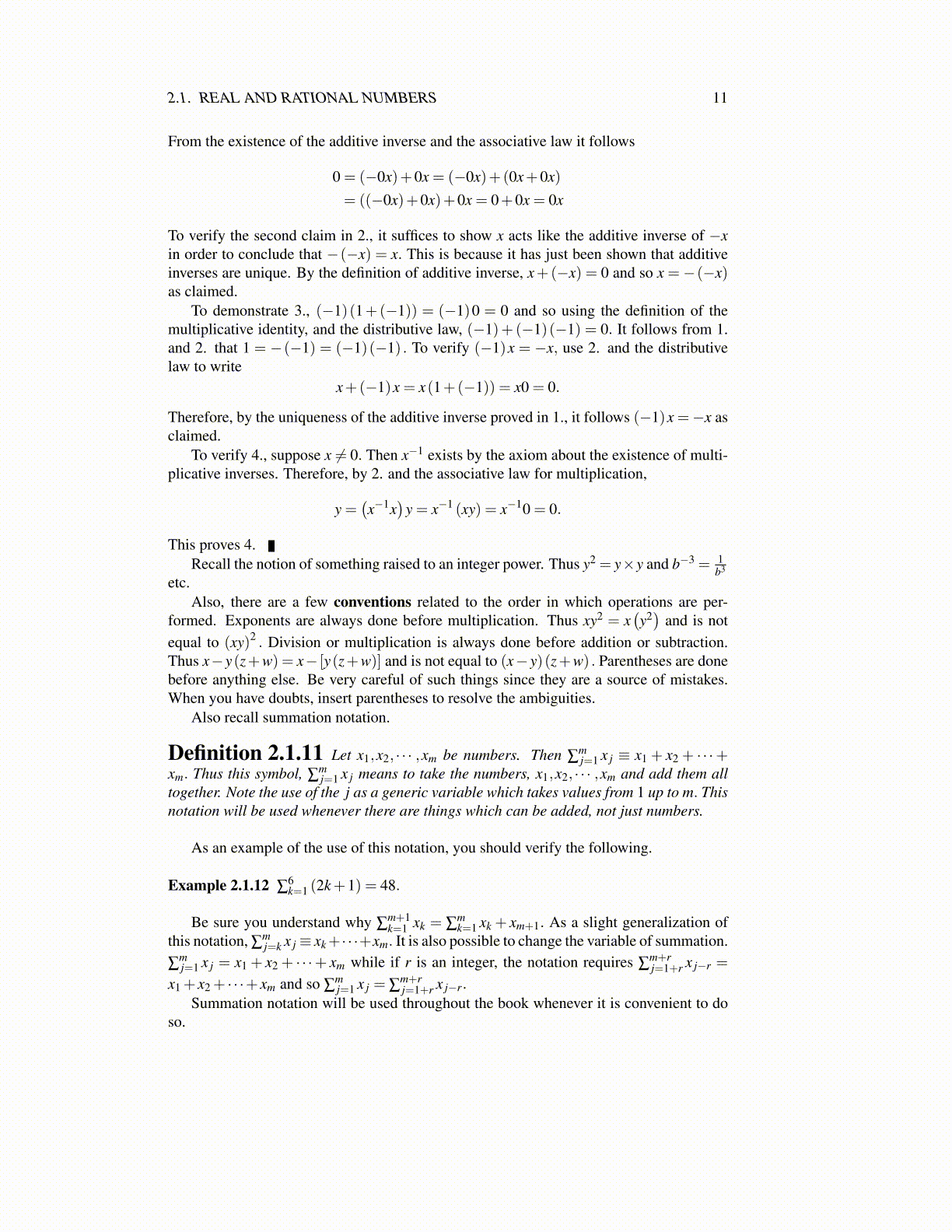
2.1. REAL AND RATIONAL NUMBERS 11
From the existence of the additive inverse and the associative law it follows
0 = (−0x)+0x = (−0x)+(0x+0x)
= ((−0x)+0x)+0x = 0+0x = 0x
To verify the second claim in 2., it suffices to show x acts like the additive inverse of −xin order to conclude that −(−x) = x. This is because it has just been shown that additiveinverses are unique. By the definition of additive inverse, x+(−x) = 0 and so x =−(−x)as claimed.
To demonstrate 3., (−1)(1+(−1)) = (−1)0 = 0 and so using the definition of themultiplicative identity, and the distributive law, (−1)+ (−1)(−1) = 0. It follows from 1.and 2. that 1 = −(−1) = (−1)(−1) . To verify (−1)x = −x, use 2. and the distributivelaw to write
x+(−1)x = x(1+(−1)) = x0 = 0.
Therefore, by the uniqueness of the additive inverse proved in 1., it follows (−1)x =−x asclaimed.
To verify 4., suppose x ̸= 0. Then x−1 exists by the axiom about the existence of multi-plicative inverses. Therefore, by 2. and the associative law for multiplication,
y =(x−1x
)y = x−1 (xy) = x−10 = 0.
This proves 4.Recall the notion of something raised to an integer power. Thus y2 = y×y and b−3 = 1
b3
etc.Also, there are a few conventions related to the order in which operations are per-
formed. Exponents are always done before multiplication. Thus xy2 = x(y2)
and is notequal to (xy)2 . Division or multiplication is always done before addition or subtraction.Thus x−y(z+w) = x− [y(z+w)] and is not equal to (x− y)(z+w) . Parentheses are donebefore anything else. Be very careful of such things since they are a source of mistakes.When you have doubts, insert parentheses to resolve the ambiguities.
Also recall summation notation.
Definition 2.1.11 Let x1,x2, · · · ,xm be numbers. Then ∑mj=1 x j ≡ x1 + x2 + · · ·+
xm. Thus this symbol, ∑mj=1 x j means to take the numbers, x1,x2, · · · ,xm and add them all
together. Note the use of the j as a generic variable which takes values from 1 up to m. Thisnotation will be used whenever there are things which can be added, not just numbers.
As an example of the use of this notation, you should verify the following.
Example 2.1.12 ∑6k=1 (2k+1) = 48.
Be sure you understand why ∑m+1k=1 xk = ∑
mk=1 xk + xm+1. As a slight generalization of
this notation, ∑mj=k x j ≡ xk+· · ·+xm. It is also possible to change the variable of summation.
∑mj=1 x j = x1 + x2 + · · ·+ xm while if r is an integer, the notation requires ∑
m+rj=1+r x j−r =
x1 + x2 + · · ·+ xm and so ∑mj=1 x j = ∑
m+rj=1+r x j−r.
Summation notation will be used throughout the book whenever it is convenient to doso.